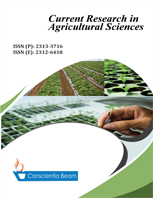Antioxidant properties, antidiabetic activity, and GC-MS phytochemical analysis of wheat-based bread fortified with celosia argentea seed flour
DOI:
https://doi.org/10.18488/cras.v11i2.3866Abstract
Pseudocereals like Celosia argentea seed have been indicated to have numerous therapeutic and prophylactic potentials that are yet to be incorporated into food materials. This study evaluated the antioxidant properties, antidiabetic potential, and phytochemicals of wheat-based bread fortified with Celosia argentea seed flour. Bread samples were produced using standard methods, fortifying refined and whole wheat with 5 and 10% Celosia argentea seed flour. The antioxidant properties and α-amylase inhibition of bread samples were determined using standard methods. The phytochemicals present in the methanolic extracts of bread samples were identified with Gas Chromatography-Mass Spectrometry (GCMS). Statistical significance was tested at α0.05. The result of the antioxidant properties for bread samples were Total flavonoid content (0.61-0.85 mg/g), Total Phenolic Content (1.1-1.31 mgGAE/g), total antioxidant capacity (1.19-3.34 mgGAE/g), Ferric reducing antioxidant power (0.13-0.54 mg/g) and DPPH (42.58-49.75%). The IC50 values obtained for Celosia argentea seed substituted wheat bread ranged between 58.20 and 171.05 μg/mL. The antioxidant properties and α-amylase inhibition showed a significant (p<0.05) increase as the percentage of inclusion of Celosiae argentea seed increased. Bioactive compounds detected in bread samples produced by the fortification of wheat flour (whole and refined) with Celosia argentea seed flour include 9,12-Octadecadienoic acid methyl ester; Docosanoic acid, methyl ester; E,E,Z-1,3,12-Nonadecatriene-5,14-diol; Linoleic acid ethyl ester; and Squalene. The predominant health benefits of phytochemicals detected in bread samples fortified with C. argentea seed were anti-inflammatory potentials, antioxidant protection, and reduction of lipid peroxidation. Including Celosia argentea seed impacted the antioxidant and antidiabetic potential of bread samples.

